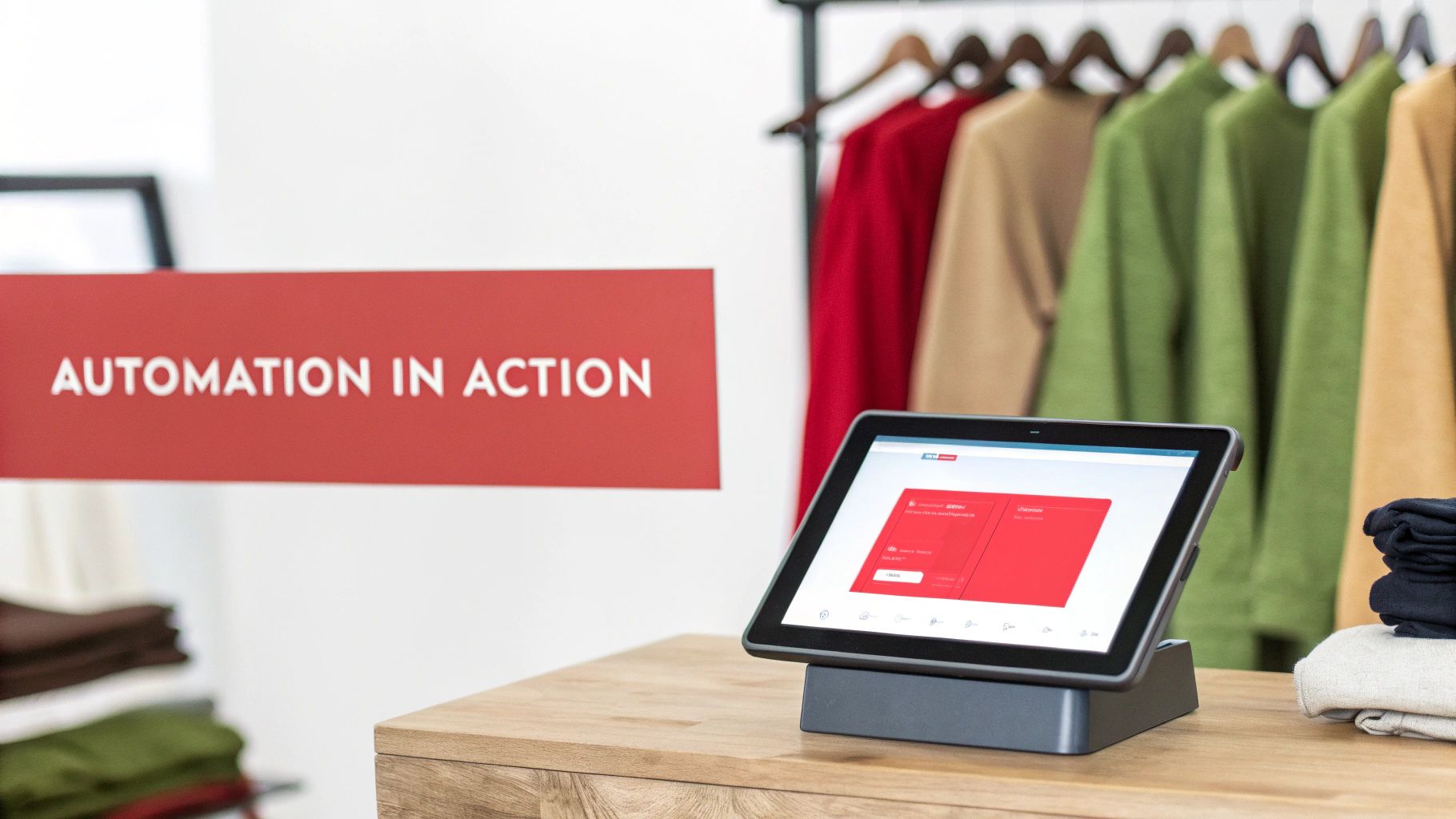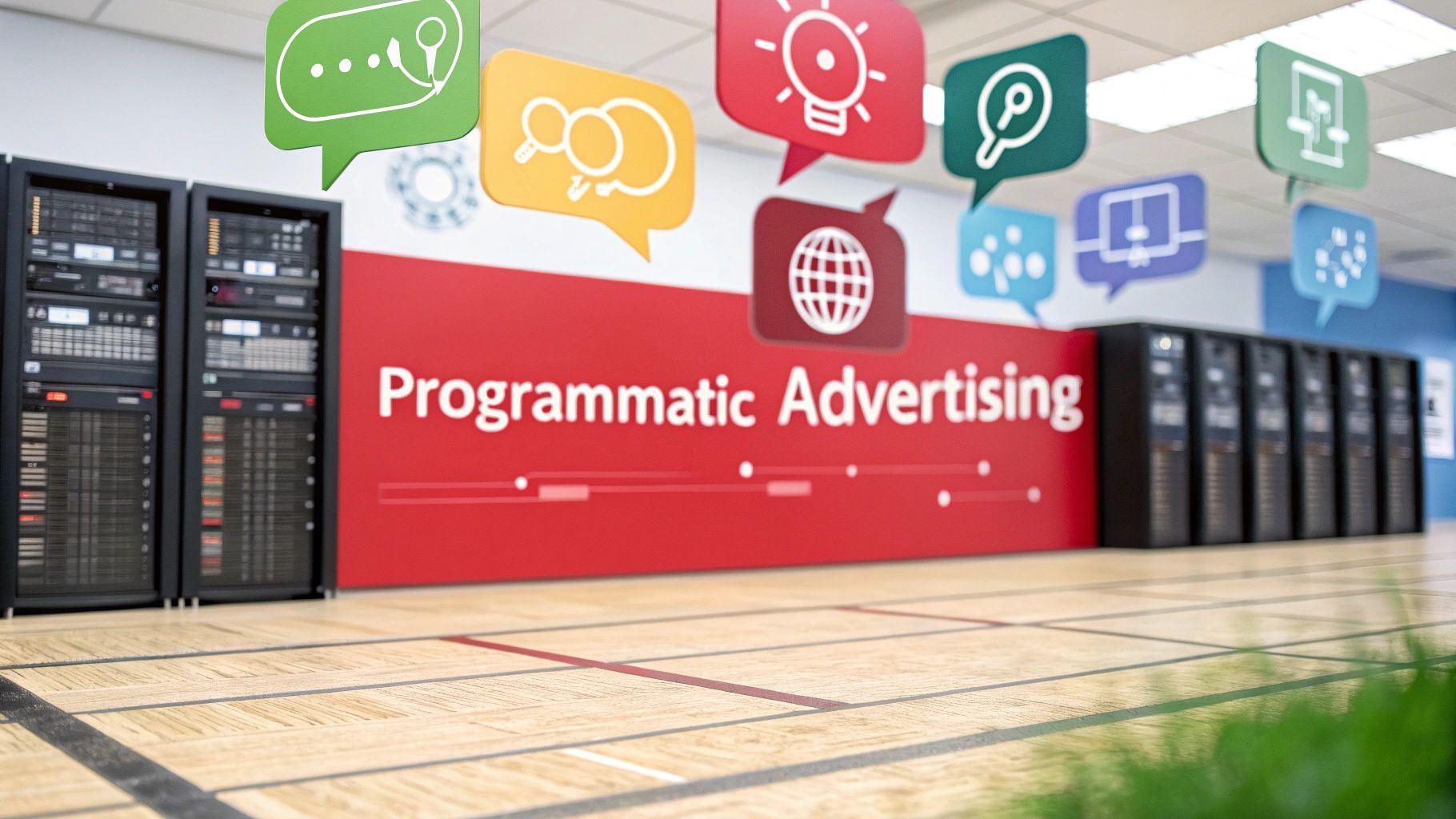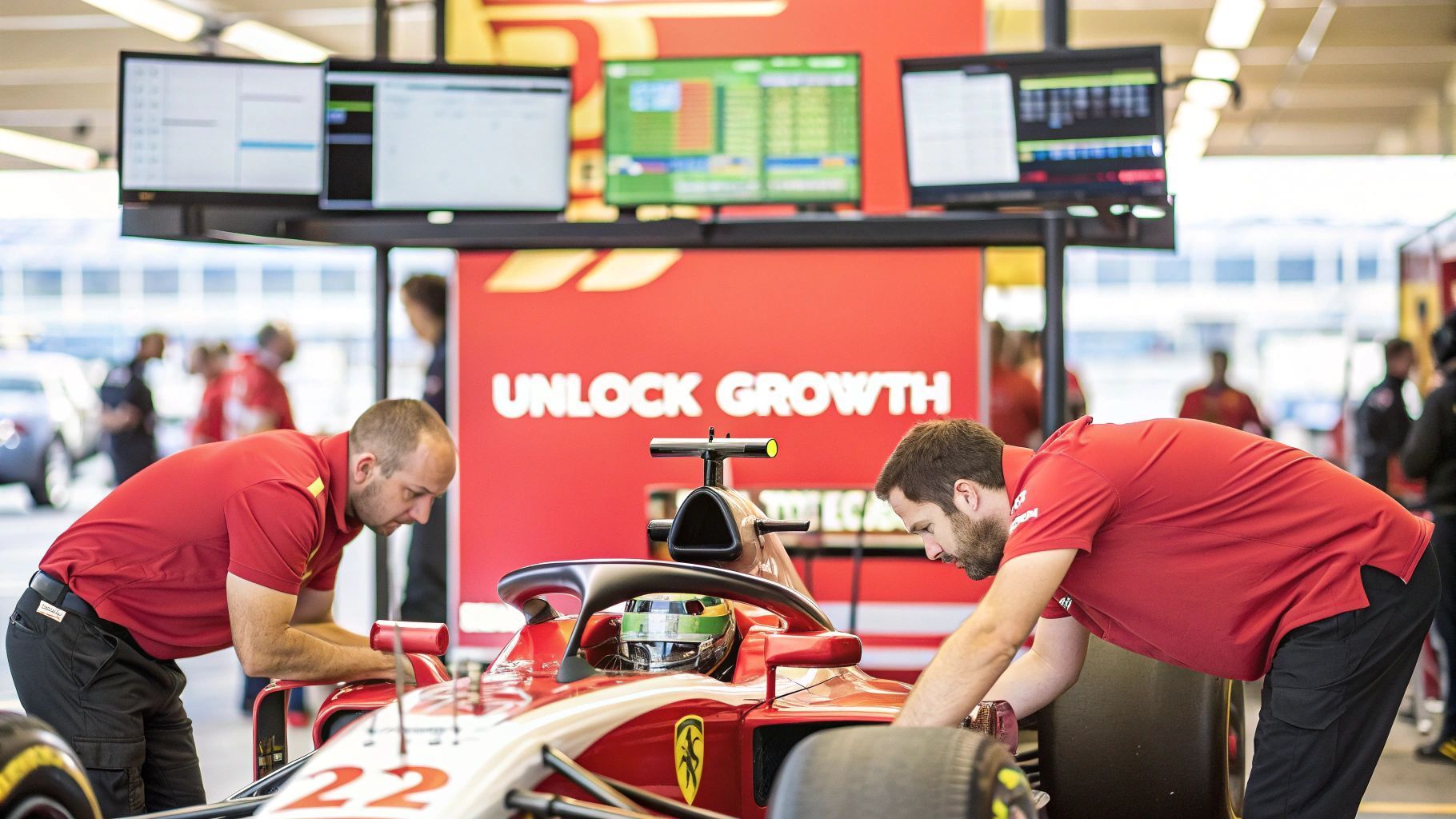What Is Marketing Automation A UK Business Guide
At its core, marketing automation is all about using smart software to handle repetitive marketing jobs. It helps businesses nurture potential customers with personalised, useful content that feels like it was written just for them.
Think of it as a tireless digital assistant who manages your campaigns, freeing up your team to focus on the bigger picture—strategy, creativity and real human connection.
Understanding Marketing Automation Beyond the Buzzwords
Imagine you're a gardener with a huge, sprawling garden. You have dozens of different plants, each with unique needs.
Trying to manually water every single one, check the soil and provide the right nutrients would be a full-time, back-breaking job. It’s inevitable you’d miss a few plants, overwater others and struggle to keep up as everything grows.
Now, what if you installed a sophisticated irrigation system? This isn't just a simple sprinkler. It’s a smart system programmed to deliver the perfect amount of water to each plant bed at the ideal time. It has sensors that know which soil is dry and which is moist.
That’s exactly what marketing automation does for your business. It doesn’t replace the gardener—your expertise is still essential—but it gives you the right tools to nurture growth efficiently and at a scale you could never manage by hand.
The Role of Automation Software
Instead of manually sending every email or posting to social media one by one, automation software takes care of it based on rules or triggers you’ve set up. This means your marketing efforts keep running around the clock, even when you’re not at your desk.
By automating routine processes, marketing teams can reclaim their most valuable asset: time. This allows them to shift their focus from repetitive tasks to high-value work like strategic planning, creative development and analysing what's actually working.
This shift is fundamental. It turns marketing from a series of disconnected, time-sucking jobs into a cohesive, intelligent system that consistently engages your audience. The goal isn’t just to save time; it's to create more meaningful and timely interactions with your customers. A business using automation well can engage with thousands of people in a personalised way—a feat that’s simply impossible to do manually.
To give you a clearer idea, here’s a quick look at the core functions these platforms handle.
Core Functions of Marketing Automation at a Glance
This table breaks down the essential tasks marketing automation software handles, showing how each one directly benefits a business.
| Function | Description | Business Benefit |
|---|---|---|
| Email Marketing | Sending automated email sequences based on user actions. | Nurtures leads with timely, relevant content without manual effort. |
| Social Media Scheduling | Planning and publishing posts across multiple platforms in advance. | Maintains a consistent online presence and saves significant time. |
| Lead Management | Scoring and routing leads to the sales team when they are ready. | Ensures sales focuses on the most promising prospects, improving conversion. |
| Reporting & Analytics | Tracking campaign performance and measuring return on investment. | Provides clear data to refine strategies and justify marketing spend. |
From sending the right email at the right time to making sure your sales team talks to the warmest leads, each function works together to create a more efficient and effective marketing machine.
The Engine Behind Your Automated Strategy
So, what exactly is marketing automation? Let's strip away the jargon. Think of it like a car engine. It’s not just one single part; it’s a collection of crucial components all working together to drive your marketing forward. Without them, you just have a box of tools, not a powerful system.
At its core, this engine has three key elements that bring your strategy to life. Together, they make sure you're not just blasting out messages but creating smart, responsive customer journeys.
Triggers: The Starting Ignition
Every automated process has to start somewhere. That starting point is a trigger . It’s a specific action a user takes that kicks off a pre-planned sequence of events. It’s the system’s way of saying, “Right, something’s happened. Time to act.”
A classic example? Someone adds a jumper to their basket on your website but leaves without buying it. That action—abandoning the cart—is the trigger. It’s the starting pistol that fires off the next part of the process, ensuring you can respond in a timely and relevant way.
Workflows: The Automated Journey
Once a trigger has been pulled, a workflow takes over. A workflow is simply a series of automated actions you've designed to guide a customer along a specific path. It's the roadmap that decides what happens next and when.
Let’s stick with our abandoned cart example. The trigger could set off a workflow that looks something like this:
- Wait 1 hour: The system gives the customer a bit of time, just in case they come back on their own.
- Send Email 1: A friendly reminder pops into their inbox: “Did you forget something?”
- Wait 24 hours: Another pause to give the customer space to think.
- Send Email 2: If there’s still no purchase, a second email goes out, maybe with a small discount to nudge them over the line.
This simple flow shows automation in action—from collecting data to launching automated steps designed to grow your business.
As you can see, it all starts with data. That data then fuels the automated sequences which, in turn, drive real business growth.
Segmentation: Grouping Your Audience
The final, crucial piece of the engine is segmentation . This is the art of organising your audience into smaller, more defined groups based on shared characteristics. Things like their purchase history, where they live or how they’ve interacted with your website.
Segmentation ensures your message is not just automated but also highly relevant. It’s the difference between shouting a generic message into a crowd and having a quiet, personal conversation.
In our abandoned cart workflow, segmentation makes things even smarter. You could create one segment for first-time shoppers and another for loyal, returning customers. The workflow could then adapt automatically, offering a 15% discount to the new shopper to seal that first purchase while simply reminding the loyal customer about their reward points.
This level of detail turns a simple reminder into a highly personalised and effective marketing action. Getting your head around these interconnected parts is a massive step towards understanding the wider world of business automation .
Why Are UK Businesses Really Getting into Automation?
Across the UK, from bright start-ups in Manchester to big-name firms in London, businesses are weaving marketing automation into the way they work. This isn’t about chasing the latest tech trend; it’s a smart move to get a proper competitive edge. The reasons are pretty straightforward: automation delivers real, measurable results that make businesses more efficient, improve customer relationships and, ultimately, grow the bottom line.
By taking over the repetitive but vital jobs, automation frees up a massive amount of time. It lets marketing teams step away from the grind of manual tasks and pour their energy into what really matters: strategy, creative ideas and building genuine connections with people. Think of it as the engine quietly powering sustainable growth in a very crowded market.
Turning More Leads into Sales
One of the biggest wins is the direct impact automation has on the quality of leads and how many of them actually become customers. Automation software is brilliant at spotting potential customers and gently guiding them along their journey. It feeds them the right information at the right time, so when they finally chat with a sales team, they're not just curious – they're properly interested and informed.
This focused approach gets impressive results. Research shows that 77% of UK business owners saw a jump in conversions after bringing in marketing automation software. This isn't magic; it comes from being able to send out personalised campaigns and properly segment audiences, turning mild interest into definite sales. To get the full story, it's worth reading up on these UK marketing automation statistics.
For so many UK businesses, marketing automation is the bridge between catching someone's eye and actually closing a deal. It makes sure no good lead gets left behind.
This systematic way of working doesn't just increase the number of leads that convert; it raises the quality of those leads from the very beginning.
Keeping Customers Loyal and Happy
Getting new customers is crucial but keeping the ones you already have is the secret to long-term success. Automation is a game-changer here, allowing businesses to stay in touch with their current clients in a way that feels consistent and meaningful. It’s all about sending the right message at the right moment to make that relationship stronger.
Imagine sending a loyal customer a personalised offer on the anniversary of their first purchase or sharing some exclusive content you know they’ll love. These are the kinds of thoughtful touchpoints that can be automated, making customers feel genuinely valued without anyone having to manage it all by hand.
This focus on retention pays off in a big way by:
- Building strong relationships through consistent, personal communication.
- Encouraging repeat business by reminding customers of your value at key times.
- Creating brand advocates who are happy to recommend you to others.
Getting a Better Return on Your Investment
At the end of the day, every marketing decision has to make financial sense. Marketing automation gives you clear, data-driven proof of its value. By making processes more efficient, it cuts down the costs that come with manual work and campaigns that just aren't hitting the mark.
For example, UK businesses have seen their marketing overheads drop by an average of 12.2% after introducing automation. This frees up budget to be used in other areas to fuel growth. With detailed analytics, marketers can see exactly which campaigns are bringing in revenue, letting them do more of what works and ditch what doesn’t. It turns automation from a simple operational tool into a core driver of profitability.
Marketing Automation in the Real World

Theory is one thing but seeing marketing automation in action is where it all clicks. To really get a feel for how it works day-to-day, let's walk through three common scenarios where automation turns routine tasks into powerful growth engines.
First, imagine a B2B technology firm. Their team needs a way to nurture fresh leads who download a white paper, guiding them from casual interest to being sales-ready, all without a single manual follow-up.
Next, picture a busy online clothing shop. They're struggling with a classic e-commerce headache: shoppers who fill their carts and then vanish. The goal here is to automatically nudge these potential customers back to finish what they started.
Finally, think about a local service business, like a physiotherapy clinic. They need a slick, efficient system to manage appointments, send out reminders and cut down on the costly no-shows that disrupt their schedule. Each of these businesses can solve their unique problems with smart automation.
Nurturing B2B Leads with a Drip Campaign
For our B2B tech firm, the customer's journey kicks off the moment they hand over their details to download a guide. That single click triggers a carefully planned workflow, designed to build trust and educate the prospect over time.
-
The Trigger: A user downloads the "Ultimate Guide to Cybersecurity".
-
The Workflow:
- Immediate Action: The system instantly sends a thank-you email with a link to the guide. No waiting.
- Wait 3 Days: It then pauses, giving the lead time to actually read the content.
- Action 2: An email follows up, sharing a case study about a similar company that got great results from their solutions.
- Wait 5 Days: Another strategic pause in the sequence.
- Action 3: The lead gets a personal invitation to a free webinar on a related topic.
-
The Result: The lead is gradually warmed up with genuinely valuable content. If they engage with multiple touchpoints (like signing up for the webinar), their lead score automatically increases. Once it hits a certain threshold, the system flags them as a hot lead and notifies a sales rep to make a personal call.
Recovering Sales with Abandoned Cart Emails
Now, let's turn to the e-commerce store. An abandoned cart isn't a lost cause; it’s a massive signal of buying intent. A quick, automated response can make all the difference.
When a potential customer abandons their online shopping cart, it's not a lost sale—it's an opportunity. An automated email workflow can recover a significant percentage of this otherwise lost revenue, often seeing recovery rates between 10% and 20% .
This is a high-impact automation that directly pumps up the bottom line. The trigger is simple: a customer leaves the site with items still in their basket. This kicks off a straightforward but incredibly effective sequence.
-
The Trigger: A customer abandons their shopping cart.
-
The Workflow:
- Wait 1 Hour: An initial email lands in their inbox with a friendly reminder, "Still thinking it over?"
- Wait 24 Hours: A second email might follow, perhaps highlighting glowing customer reviews for the items in their cart.
- Wait 48 Hours: A final email could offer a small, time-sensitive nudge, like 10% off , to encourage them to seal the deal.
-
The Result: A good chunk of those shoppers will come back and complete their purchase, boosting sales figures without anyone on the marketing team lifting a finger.
The difference between tackling these tasks manually versus with automation is night and day. One approach is reactive and impossible to scale, while the other is proactive, efficient and relentlessly consistent.
Manual vs Automated Marketing Tasks: A Comparison
To put it into perspective, let's look at how some common marketing jobs stack up when done by hand versus with an automated system.
| Marketing Task | Manual Approach | Automated Approach |
|---|---|---|
| Follow-up Emails | Remembering to send emails one by one; often forgotten or inconsistent. | Emails are sent automatically based on set triggers and perfect timing. |
| Lead Nurturing | Patchy contact at best; good leads inevitably fall through the cracks. | Every lead receives a consistent, personalised journey from day one. |
| Reporting | Manually pulling data from different places; a time-consuming headache. | The platform generates real-time reports on campaign performance, instantly. |
As you can see, automation isn't just about saving time. It's about creating a more reliable, effective and scalable marketing machine that works for you 24/7.
How to Choose Your First Automation Platform

Picking your first marketing automation platform feels like a huge commitment but it doesn’t have to be terrifying. The trick is to start smart, not big. Focus on a tool that solves one or two of your biggest headaches right now, instead of paying for a complex system with features you won’t touch for years.
Think about your immediate goals. Is it about nurturing new leads more consistently? Or maybe you just need a better way to welcome new customers and keep them engaged? Nailing down these high-impact problems first will guide your decision and help you see a return on your investment much faster.
This phased approach stops you from getting lost in complexity. Your first platform should be a powerful ally that grows with you, not a confusing piece of software that gathers dust.
Key Questions to Ask Before You Commit
Before you even think about demos, take a step back and look at your own business. Answering these simple questions will give you a clear checklist, making it much easier to filter your options and find the right fit.
- What is your budget? Be honest about what you can afford each month or year. Most platforms have tiered pricing, so get clear on what features are included at each level.
- How big is your team? Some tools are perfect for solo operators, while others are built for large marketing departments. Think about how easy it is to use and the level of technical skill needed.
- What systems do you already use? Your new platform must integrate seamlessly with your existing setup, especially your CRM. A clunky integration will just create more manual work, which is the opposite of what you want.
To help with this crucial choice, looking at a good marketing automation tools comparison can help you weigh up the features and benefits of different platforms. If you're just starting out, our guide to the top 10 best free email marketing platforms for 2025 is an excellent place to begin.
Preparing for a Smooth Launch
The success of your marketing automation depends as much on your prep work as the platform itself. A powerful tool is only useful if it’s set up correctly from the start. Taking the time to get ready will ensure everything runs smoothly from day one.
The groundwork you lay before implementing a marketing automation platform is crucial. Clean data, clear objectives and a well-trained team are the foundations of any successful automation strategy. Getting these right from day one will save countless hours of frustration later.
Many UK businesses are putting their focus here. In a recent survey, 15% of UK businesses said that improving marketing automation was a top priority for 2025. On top of that, 44% of companies are now using AI for their marketing automation, showing just how important these tools have become.
Focus on these three essential preparation steps:
- Clean Your Data: Your automation platform runs on data. Make sure your contact lists are up-to-date, organised and free of duplicates to get the best results.
- Define Clear Goals: Know exactly what you want to achieve. Set measurable targets, like "increase qualified leads by 20% in six months".
- Train Your Team: Make sure everyone who will use the platform understands what it's for and how to use it properly. This is key to getting everyone on board and making it a success.
The Future of Automation in the UK
Marketing automation isn't standing still; it’s getting smarter, faster and more woven into the fabric of UK business. The future isn't about just sending more emails. It's about creating genuinely predictive and seamless customer experiences that anticipate what someone needs, often before they realise it themselves.
This forward momentum is clear from the market's rapid expansion. The UK's marketing automation sector is tipped to grow at a compound annual growth rate ( CAGR ) of 13.9% from 2025 to 2030 . While email marketing was still the dominant force in 2024, making up 26.12% of total revenue , new technologies are quickly reshaping the game. You can explore more on these trends in this comprehensive market outlook.
The Rise of Predictive AI
The next wave of automation is being driven by Artificial Intelligence (AI). Instead of relying on simple "if this, then that" rules, AI-powered platforms can now analyse vast amounts of data to predict customer behaviour. This allows for a level of hyper-personalisation that was once the stuff of science fiction.
AI transforms automation from a reactive tool into a proactive one. It moves beyond just responding to customer actions to anticipating their future needs, allowing businesses to offer the right solution at the perfect moment.
This means systems can dynamically adjust marketing messages based on subtle behavioural cues, creating a truly individual journey for every single user. Our detailed article explains more about how artificial intelligence is revolutionising digital marketing and the impact it's having.
Omnichannel Experiences and Data Privacy
Looking ahead, automation will break free from isolated channels. True omnichannel automation will become the standard, seamlessly connecting experiences across email, social media, SMS and even in-person interactions. This ensures a consistent and cohesive brand conversation, no matter where the customer engages.
At the same time, data privacy will remain front and centre. As automation gets more intelligent, sticking to regulations like GDPR is non-negotiable. Future platforms will have advanced features to ensure smarter marketing also means safer marketing, building customer trust through transparent and responsible data use. Staying ahead means embracing both innovation and integrity.
Your Marketing Automation Questions Answered
Here are a few straight answers to the questions we hear most often from business owners and marketers.
Is Marketing Automation Only For Large Companies?
Not at all. While the big players definitely get a lot out of it, many of the best platforms today are built specifically for small and medium-sized businesses (SMBs).
These tools are far more affordable and user-friendly than their enterprise-level cousins. They let smaller teams automate crucial tasks like email marketing and lead nurturing, all without needing a massive budget or a dedicated IT department. The trick is to pick a platform that can grow with you.
Will Marketing Automation Feel Impersonal To My Customers?
This is a common worry but good marketing automation actually does the opposite. By using data like a customer’s purchase history or how they’ve browsed your site, you can send messages that are incredibly relevant and perfectly timed.
Trying to achieve that level of personalisation manually is almost impossible. The goal isn’t to replace the human touch but to use technology to make every single communication feel like it was meant just for them.
The real power of marketing automation is in delivering personalised experiences at scale. It uses customer data to create communications that feel one-to-one, strengthening relationships instead of making them feel robotic.
How Does Marketing Automation Differ From A CRM?
Think of it this way: a Customer Relationship Management (CRM) system is your address book and diary combined. It’s a database for managing all your customer information and sales conversations. Marketing automation software, on the other hand, is the engine that runs and automates your marketing campaigns.
The two work best when they’re talking to each other. Your CRM holds the customer data and your marketing automation platform uses that data to run targeted campaigns. It then feeds all the engagement data—like email opens and link clicks—back into the CRM, giving your sales team a complete picture of a lead’s journey.
Ready to drive real growth with a focused, data-driven marketing strategy? The team at Superhub specialises in creating bespoke automation systems that deliver measurable results. Find out how we can help your business thrive.





